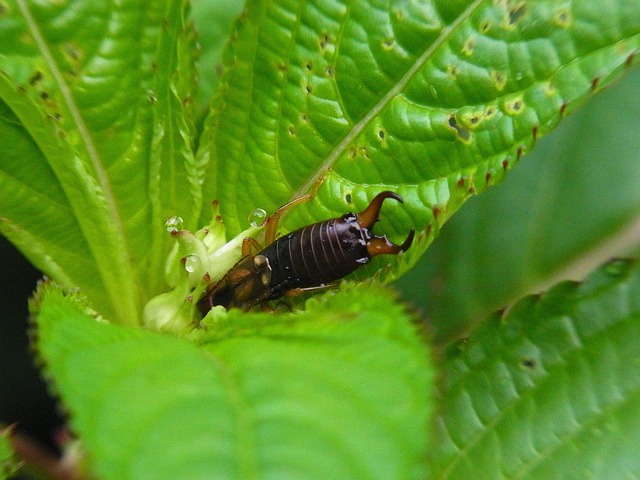Earwigs, nocturnal insects hiding in dark, damp places, can be controlled via tailored strategies called customized earwig control plans. These plans involve identifying and sealing their hiding spots, disrupting breeding cycles, and using targeted treatments while regularly monitoring for adjustments, offering safe, effective, and humane pest management.
“Uncover the enigmatic world of earwigs, as we explore their peculiar behavior and life cycles in this comprehensive guide. Understanding these insects is the first step towards effective management, especially when they invade your home or garden.
We’ll reveal common hiding spots, from dark crevices to lush foliage, where these creatures prefer to lurk. Learn to identify earwigs through visual cues and signs, enabling you to implement tailored customized earwig control plans for a pest-free environment.”
Understanding Earwigs: Behavior and Life Cycle
Earwigs, despite their intimidating name, are small insects with a peculiar appearance and an interesting life cycle. They belong to the Forficula family, characterized by their long antennae and distinctive forceps-like hind legs. These creatures prefer darkness and damp environments, which makes them excellent at hiding. Understanding their behavior is crucial for effective earwig control plans.
Earwigs are primarily nocturnal and tend to avoid light. During the day, they seek shelter in narrow crevices, under rocks or leaves, and even in human homes. They are attracted to moisture, often lurking in damp areas like basements, bathrooms, and kitchens. Their life cycle involves several stages: egg, nymph, and adult. With customized earwig control plans, homeowners can effectively manage these pests by identifying their hiding spots, sealing entry points, and using targeted treatments to disrupt their breeding cycles.
Common Hiding Spots in Homes and Gardens
Earwigs are elusive creatures that prefer to stay hidden, making their presence often hard to detect until they’ve already established a comfortable habitat. In homes and gardens, these pests tend to seek shelter in dark, moist areas where they can easily blend into the environment. Common hiding spots include cracks and crevices in walls, floors, and ceilings; under sinks, appliances, and furniture; as well as in potted plants, garden beds, and compost piles. Their preference for humid conditions often leads them to congregate near water sources like bathrooms, kitchens, and laundry rooms.
For effective earwig control, understanding these hiding spots is key. Customized earwig control plans can be developed to target these areas with specific treatments, ensuring a safe and efficient solution. Regular inspections and maintenance, especially in moist environments, can significantly reduce the risk of an earwig invasion. By addressing their preferred habitats, homeowners can create an environment that discourages these pests from taking up residence, keeping both the home and garden free from unwanted visitors.
Identifying Earwigs: Visual Clues and Signs
Earwigs, despite their unappealing nature, can often go unnoticed due to their elusive behavior. One of the best ways to identify an earwig invasion is by recognizing visual clues and signs they leave behind. These insects are typically brown or black, elongated, and have a flattened body shape, allowing them to squeeze into tiny crevices. Look for these distinctive features: a pair of cerci (appendages at the rear) that resemble forceps, and long, delicate antennae. They prefer moist environments, so areas with high humidity, such as under rocks or logs, behind walls, or in potted plants, may attract them.
If you suspect an earwig infestation, don’t panic! Customized earwig control plans can be devised to target these pests humanely and effectively. Professional pest control services offer tailored solutions, ensuring that these critters are removed from your living spaces and prevented from returning.
Customized Earwig Control Plans: Strategies for Effective Management
Earwigs, despite their unappealing nature, can be managed through tailored strategies known as customized earwig control plans. These plans are designed to target specific hiding spots where earwigs tend to congregate, such as under debris, in cracks and crevices, or around plants and vegetation. A key component involves regularly inspecting these areas with a focus on eliminating any signs of their presence.
Customized control plans also incorporate integrated pest management (IPM) techniques. This includes using non-chemical methods like sealing entry points, maintaining good sanitation, and introducing natural predators. For stubborn cases, targeted applications of approved insecticides can be part of the strategy. Regular monitoring and adjustments to these plans ensure their effectiveness over time, providing a comprehensive and humane approach to earwig management.
Understanding earwig behavior and their life cycle is key to implementing effective management strategies. By identifying common hiding spots and visual clues, you can proactively manage earwig infestations with customized earwig control plans tailored to your home or garden. Armed with this knowledge, you’re better equipped to protect your living spaces from these intruders and maintain a peaceful environment.
